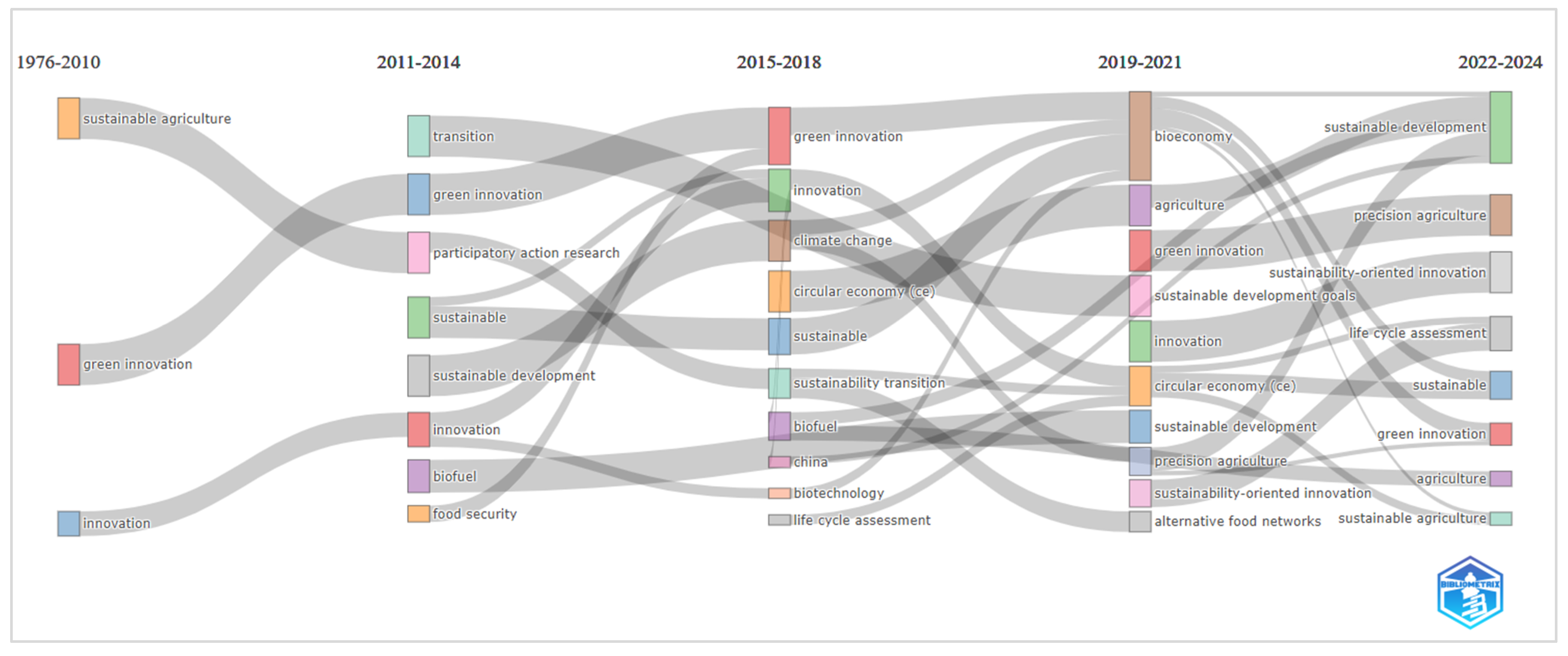Charting the Landscape: Perspectives on Green Innovations in Agriculture †
Abstract
1. Introduction
2. Material and Methods
3. Results
4. Conclusions
Author Contributions
Funding
Institutional Review Board Statement
Informed Consent Statement
Data Availability Statement
Conflicts of Interest
References
- Food and Agriculture Organization of the United Nations (FAO). The State of Food Security and Nutrition in the World 2023. Urbanization, Agrifood Systems Transformation and Healthy Diets Across the Rural–Urban Continuum; FAO: Rome, Italy, 2023. [Google Scholar] [CrossRef]
- El Bilali, H. Relation between innovation and sustainability in the agro-food system. Ital. J. Food Sci. 2018, 30, 200–225. [Google Scholar] [CrossRef]
- Tartaruga, I.; Sperotto, F.; Carvalho, L. Addressing inclusion, innovation, and sustainability challenges through the lens of economic geography: Introducing the hierarchical regional innovation system. Geogr. Sustain. 2024, 5, 1–12. [Google Scholar] [CrossRef]
- Aria, M.; Cuccurullo, C. Bibliometrix: An R-tool for comprehensive science mapping analysis. J. Informetr. 2017, 11, 959–975. [Google Scholar] [CrossRef]
- Cobo, M.J.; López-Herrera, A.G.; Herrera-Viedma, E.; Herrera, F. An approach for detecting, quantifying, and visualizing the evolution of a research field: A practical application to the Fuzzy Sets Theory field. J. Informetr. 2011, 5, 146–166. [Google Scholar] [CrossRef]
- Mirabella, N.; Castellani, V.; Sala, S. Current options for the valorization of food manufacturing waste: A review. J. Clean. Prod. 2014, 65, 28–41. [Google Scholar] [CrossRef]
- Matos, S.; Hall, J. Integrating sustainable development in the supply chain: The case of life cycle assessment in oil and gas and agricultural biotechnology. J. Oper. Manag. 2007, 25, 1083–1102. [Google Scholar] [CrossRef]
- Padel, S. Conversion to Organic Farming: A Typical Example of the Diffusion of an Innovation? Sociol. Rural. 2001, 41, 40–61. [Google Scholar] [CrossRef]
- Notarnicola, B.; Tassielli, G.; Renzulli, P.; Castellani, V.; Sala, S. Environmental impacts of food consumption in Europe. J. Clean. Prod. 2017, 140, 753–765. [Google Scholar] [CrossRef]
- Geels, F.; Sovacool, B.; Schwanen, T.; Sorrel, S. The Socio-Technical Dynamics of Low-Carbon Transitions. Joule 2017, 1, 463–479. [Google Scholar] [CrossRef]


Disclaimer/Publisher’s Note: The statements, opinions and data contained in all publications are solely those of the individual author(s) and contributor(s) and not of MDPI and/or the editor(s). MDPI and/or the editor(s) disclaim responsibility for any injury to people or property resulting from any ideas, methods, instructions or products referred to in the content. |
© 2025 by the authors. Licensee MDPI, Basel, Switzerland. This article is an open access article distributed under the terms and conditions of the Creative Commons Attribution (CC BY) license (https://creativecommons.org/licenses/by/4.0/).
Share and Cite
Sperotto, F.; Tartaruga, I. Charting the Landscape: Perspectives on Green Innovations in Agriculture. Proceedings 2025, 113, 13. https://doi.org/10.3390/proceedings2025113013
Sperotto F, Tartaruga I. Charting the Landscape: Perspectives on Green Innovations in Agriculture. Proceedings. 2025; 113(1):13. https://doi.org/10.3390/proceedings2025113013
Chicago/Turabian StyleSperotto, Fernanda, and Iván Tartaruga. 2025. "Charting the Landscape: Perspectives on Green Innovations in Agriculture" Proceedings 113, no. 1: 13. https://doi.org/10.3390/proceedings2025113013
APA StyleSperotto, F., & Tartaruga, I. (2025). Charting the Landscape: Perspectives on Green Innovations in Agriculture. Proceedings, 113(1), 13. https://doi.org/10.3390/proceedings2025113013






